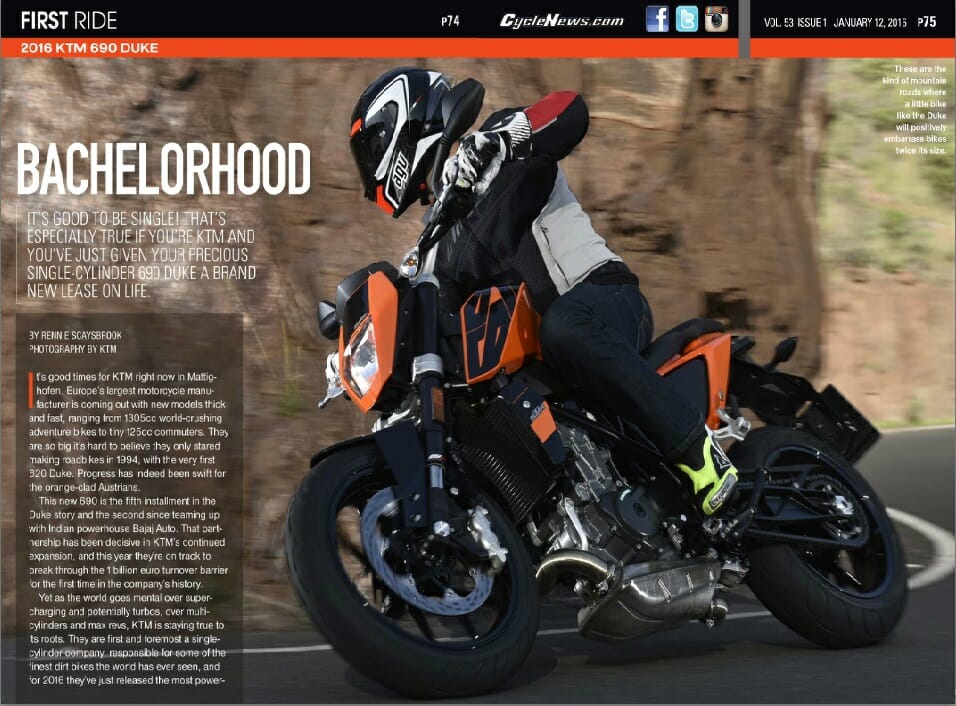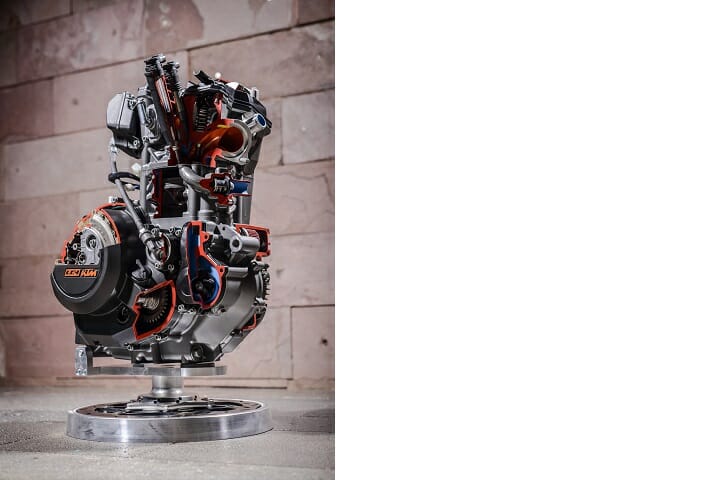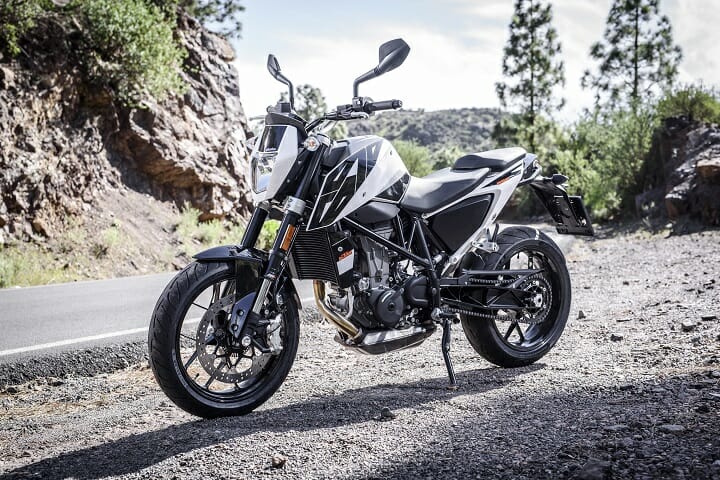Rennie Scaysbrook | January 21, 2016
 These are the kind of mountain roads a little bike like the Duke will positively embarrass bikes twice its size.
These are the kind of mountain roads a little bike like the Duke will positively embarrass bikes twice its size.
Bachelorhood – It’s good to be single! That’s especially true if you’re KTM and you’ve just given your precious single-cylinder 690 Duke a brand-new lease on life.
It’s good times for KTM right now in Mattighofen. Europe’s largest motorcycle manufacturer is coming out with new models thick and fast, ranging from 1305cc world-crushing adventure bikes to tiny 125cc commuters. They are so big it’s hard to believe they only started making road bikes in 1994, with the very first 620 Duke. Progress has indeed been swift for the orange-clad Austrians.
This new 690 is the fifth installment in the Duke story and the second since teaming up with Indian powerhouse, Bajaj Auto. That partnership has been decisive in KTM’s continued expansion, and this year they’re on track to break through the €1 billion turnover barrier for the first time in the company’s history.

You can read the original magazine story by clicking HERE.
Yet as the world goes mental over supercharging and potentially turbos, over multi-cylinders and max revs, KTM is staying true to its roots. They are first and foremost a single-cylinder company, responsible for some of the finest dirt bikes the world has ever seen, and for 2016 they’ve just released the most powerful production single ever, in the new 690 Duke.
The single-cylinder LC4 engine has been a cornerstone of KTM’s on-road success. Over 68,000 LC4-powered machines have found homes since 1994, but considering KTM is the only manufacturer who continues to develop large-capacity single-cylinder road bikes, the fact they have brought an essentially all-new engine to the market is cause for applause.
 It may look similar to the old one, but KTM’s given the little Duke a solid work-over for 2016.
It may look similar to the old one, but KTM’s given the little Duke a solid work-over for 2016.
The chassis is largely identical to the previous-generation 690 that debuted in 2012, albeit with a few geometry changes aimed at inducing a touch more steering stability, and this is the first Duke to come with a full house of electronics including multiple rider modes, traction control and ABS. There’s even a super special Duke 690 R, which means absolutely nothing to the U.S. because we are one of the few markets in the world that won’t be getting it. Sad face.
The chance to sample both the 690 and 690 R came in the switchback-riding paradise that is the Canary Islands, a North Atlantic island hideaway halfway between Senegal in Africa and Portugal in Europe, famed for bloated German tourists wearing far too little clothes and eating far too much food. Only some areas of island life are pleasing to the eye.
 The white color scheme is a little more subdued that the in-your-face KTM orange, a little more stealth, if you will.
The white color scheme is a little more subdued that the in-your-face KTM orange, a little more stealth, if you will.
If you were to put the old Duke side by side with the new one, you’d be forgiven for thinking they’re exactly the same. And aesthetically they are, but the first sign of change comes before you even fire the new bike up. The riding dimensions are slightly altered, the seat narrower where it meets the tank and the padding itself a touch firmer, which I was glad for over a 150-mile ride, as the old one would have me standing on the ’pegs far too early in an effort to get blood flowing down the pins. The ’pegs themselves are in the same place as before, but on the R model they’re raised a touch to increase ground clearance and get you more in the race tuck.
 The slightly altered seat profile makes for a much more comfortable ride than before.
The slightly altered seat profile makes for a much more comfortable ride than before.
The second hint comes in the form of the completely reworked dash, which looks like something from this century, rather than the Gameboy face of the old bike. And it’s clever, too. If the engine is cold, the digital rev counter is highlighted blue, once up to temp it changes to black during low-rpm riding and red when you start getting high in the revs. Not only that, the gear indicator turns from black to red when it’s time to shift at high rpm and the entire display switches from white with black numbers during the day, to black with white numbers at night—very cool. But aside from the light show, the dash is now much easier to use via the toggle switch on the left bar—everything is spaced out and easy to navigate and it’s easy to see KTM has put a lot of thought into an area many bike manufacturers consider almost an afterthought.
 The brand-new dash is one of the best units we’ve tried on any bike in recent years.
The brand-new dash is one of the best units we’ve tried on any bike in recent years.
Firing up the new Duke, you still get that muffled drone from the Euro 4-compliant exhaust the old bike produced, but the throttle is lighter, with more immediacy in the time it takes for the revs to rise after the right wrist is turned, and even at standstill the lack of vibrations is impressive. The whole engine has been completely reworked (see breakout), with one of the top priorities being to reduce the annoying vibrations inherent with large-capacity singles. Not only have the engine designers met this target, they’ve worked together with the electronics department to deliver a ride-by-wire throttle response that feels almost as smooth as a BMW parallel twin, rather than a KTM single. Where the old 2012 bike used to hunt and fart on partial throttle in any of the first three gears, the new Duke will happily ride along without you feeling like you’re on a bucking bronco.
There’s clearly more go to match the reduced vibrations, although I’m not sure 73 horsepower would be the final number you’d see on the dyno. To me it feels more about 60-65 horsepower, but that’s still damn impressive when you consider a larger capacity twin-cylinder Yamaha FZ-07 makes about 68 horsepower on a good day.
If you choose to buy the Track Pack, and for the money I’d suggest you do, you’ll get two extra riding modes (Rain and Sport), traction control, Supermoto ABS and Motor Slip Regulation as the standard bike only gets basic ABS and the Street riding mode. Switching from Street to Rain mode, the power is instantly dulled to the point where this thing feels like a 400, while Sport mode lets the Duke have its head a little more, with a more direct throttle response. It’s not like you get an extra 20 horsepower, but the difference in throttle response is noticeable enough. I like the immediacy of the Sport map, so after I’d sampled the other two I just left it there.
 Brembo four-piston brakes and Bosch ABS handle stopping duties superbly.
Brembo four-piston brakes and Bosch ABS handle stopping duties superbly.
But the big factor with this new engine is the reduced oscillating vibrations—it’s amazing a single cylinder is now this smooth. I used to work at a KTM dealer when I was 15 and rode a LC4 620 dirt bike a few times, and that was as close to a jackhammer on wheels as I think I’ll ever get. We have certainly come a long way with single-cylinder engines.
You can ride in sixth gear at 65 mph and the bike won’t shake itself to pieces anymore, and now the 690 really feels like the little brother to my 1290 Super Duke R in there’s plenty of punch in the short first three gears, with the final three gears getting progressively taller to a sixth gear that’s almost an overdrive. Suddenly doing a big trip on a 690 Duke actually seems feasible.
Comfort has never been a big issue for me on the 690 as the ’peg and handlebar position is pretty much spot on for my size, so it’s nice KTM hasn’t messed much with it. That’s basically true for the chassis in general, although the slightly more relaxed geometry of the 2016 chassis has gifted a touch more stability when cornering. It’s not wildly different to the old bike, and the suspension and brakes are basically the same as previously, so you’ll still get a comfortable ride up until you really start to push the bike hard. At that point you’ll quickly overload those softly suspended forks and the Duke will quickly start to get a bit out of hand, but if you’re riding nice and smooth and not hammering the brakes into corners, you’ll get a pretty smooth ride.
 The ultimate urban weapon? If you lived deep in the city jungle, it just might be.
The ultimate urban weapon? If you lived deep in the city jungle, it just might be.
Should you want to up the chassis-performance game you’ll need to head to the KTM Powerparts catalog to get a WP race shock and some fork internals—that’s basically what the Duke 690 R has and with that you’ll also get an extra 15mm of suspension travel: might be well worth it if you’re on the heavier side.
The 690 Duke is certainly a worthy successor to the 2012 model that I feel missed the mark somewhat. The lighter internals and reduced vibrations make this bike a far better proposition and it’s now a genuine alternative for someone who wants a super-light bike they can commute on as easily as they can take weekend trips with. It’s a shame we don’t get the 690 R because that thing is so much fun, but you can almost up-spec your standard bike (at considerable cost) to the level of a 690 R, if you so desire.
But even with no 690 R on the U.S. horizon, there’s no denying KTM has created an excellent bike in the 690 and has given the venerable single-cylinder road bike yet another new lease on life.

That Engine
KTM’s main objective in creating the new 690 Duke was to bring this engine right up to modern-day technology standards and to do that, they had to go through the entire engine. The result is a 7-percent power increase to 73 horsepower and a 6-percent torque increase to 54 lb-ft.
“We had to redesign many aspects of the engine,” starts lead engine designer Sebastian Faistauer. “In the cylinder head we added an additional balancer shaft, which is working alongside a completely new crankshaft, conrod and piston. We changed the timing chain to a new silent system; prior to this we were using roller chains but with the new silent system there were two benefits. The first being the system is much smaller, and the second is increased durability.”
The cylinder head in the new 690 still uses a single camshaft design, but at first glance you’d be forgiven for thinking it’s a twin cam due to the balancer shaft at one end.
“This design therefore means less weight and less oscillating masses and vibrations, which you instantly feel on the road,” said Faistauer. “The intake valves are controlled using DLC (Diamond Like Carbon) coated finger followers and we are using a directly controlled (i.e, acting directly off the camshaft) rocker arm on the exhaust valves. We used a lot of our twin-cylinder experience in creating this new intake system.”
Magnesium was used in the creation of the valve cover, saving a precious few grams, and the resonator chamber located in the inlet tract. “With this configuration,” states Faistauer, “we can ensure much better emissions figures and reduced fuel consumption.”
Down the bottom of the engine, the crankshaft’s stroke has been increased 4.5mm to 80mm, bore decreased 3mm to 105mm, and the conrod, pumping up and down a new forged piston, utilizes new plain bearings at the big end have been used to minimize friction within the crank drive.
“This design is much more compact than before and helps to further reduce the oscillating masses and increase the durability of the system,” says Faistauer. “This further enhances rideability and a smoother throttle response, and we have managed to nearly halve the vibrations from the crank drive over the previous model.”
The engine utilizes ride-by-wire with twin-spark ignition, part of the reason the Duke is so smooth at the bottom of the rev range. The exhaust has also been changed and is now 2.2 pounds lighter.
“In all, we’ve managed to increase the power range to 9000 rpm and this, combined with the much better rideability and decreased vibrations, make this new engine a big improvement over the old one,” says Faistauer.

Specifications – 2016 KTM 690 Duke
Engine: Single-cylinder four-stroke, liquid-cooled
Displacement: 690cc
Bore x stroke: 105 x 80mm
Horsepower: 73 hp @ 8000 rpm (claimed)
Torque: 54 lb-ft @ 6500 rpm (claimed)
Compression ratio: 12.7:1
Transmission: Six-speed
Chassis: Tubular steel trellis
Front suspension: 43mm WP inverted cartridge fork
Rear suspension: Single WP shock absorber
Front brake: Twin 320mm discs, Brembo four-piston calipers, ABS
Rear brake: Single 240mm disc, Brembo single-piston caliper, ABS
Front tire: 120/70 R17
Rear tire: 160/60 R17
Steering-head angle: 63.5 degrees
Trail: N/A
Wheelbase: 57.7 in.
Seat height: 32.8 in.
Fuel capacity: 3.6 gal.
Weight: 405 lbs (wet, claimed).
Colors: Orange/White
MSRP: $8,999 as tested
You can read the original magazine story by clicking HERE.
For more Cycle News Standard motorcycle reviews, click HERE.
For more KTM motorcycle reviews, click HERE.